Click on images to enlarge
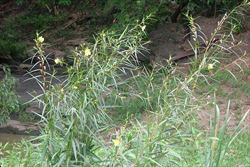
habit (Photo: Sheldon Navie)
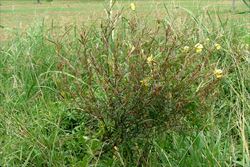
habit (Photo: Sheldon Navie)

elongated and hairless glossy leaves (Photo: Sheldon Navie)
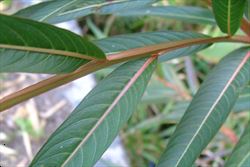
close-up of four-angled, slightly winged, stem and leaves with reddish-coloured mid-ribs (Photo: Sheldon Navie)
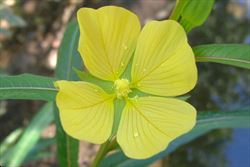
close-up of flower with four broad yellow petals (Photo: Sheldon Navie)
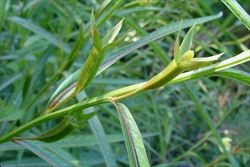
young fruit with four large persistent sepals (Photo: Sheldon Navie)

immature, four-angled, hairless fruit (Photo: Sheldon Navie)

mature fruit releasing their numerous tiny seeds (Photo: Sheldon Navie)

seedlings (Photo: Sheldon Navie)

comparison of the seedlings of native willow primrose (Ludwigia octovalvis), on the left, and long-leaved willow primrose (Ludwigia longifolia), on the right (Photo: Sheldon Navie)
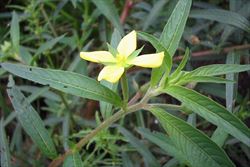
native willow primrose (Ludwigia octovalvis), with round hairy stems and hairy leaves (Photo: Sheldon Navie)
Scientific Name
Ludwigia longifolia (DC.) H. Hara
Synonyms
Jussiaea longifolia DC.
Family
Onagraceae
Common Names
longleaf primrose willow, longleaf primrose-willow, longleaf willow primrose, long-leaved willow primrose, primrose willow
Origin
Native to South America (i.e. southern Brazil, Paraguay, Uruguay and northern Argentina).
Cultivation
This species was introduced as a garden ornamental for aquatic situations, though it is not common in cultivation.
Naturalised Distribution
Naturalised in the coastal districts of central and northern New South Wales and in south-eastern Queensland.
Also naturalised overseas in south-eastern USA (i.e. Florida).
Habitat
Long-leaved willow primrose (Ludwigia longifolia) is currently a weed of waterways and wetlands (e.g. swamps, marshes, drains, gullies, channels and riparian vegetation) in the warmer temperate and sub-tropical regions of Australia. It also has the potential to spread further northwards into tropical regions.
Habit
A small upright (i.e. erect) shrub or large herbaceous plant usually growing 0.5-2 m tall, but occasionally reaching up to 3 m in height. It can be short-lived (i.e. annual) or relatively long-lived (i.e. perennial).
Distinguishing Features
- a small upright shrub usually growing 0.5-2 m tall.
- its hairless stems are conspicuously square in cross-section and usually also somewhat winged.
- its elongated leaves are hairless or almost hairless (5-35 cm long and 4-25 mm wide) and glossy in appearance.
- its bright yellow flowers have four greenish or reddish sepals and four, or rarely five, bright yellow petals.
- its hairless fruit are sharply four-angled (10-42 mm long and 4-8 mm wide) and contain large numbers of tiny dust-like seeds.
Stems and Leaves
The stems are hairless (i.e. glabrous) and are usually much-branched towards the top of the plant. Younger stems are green or more often reddish in colour (especially when growing in a sunny position), conspicuously square in cross-section (i.e. quadrangular), and usually also somewhat winged. However, they become rounded and somewhat woody with age and may eventually develop a reddish-brown coloured bark.
The leaves are alternately arranged along the stems and do are stalkless (i.e. sessile). They are hairless or almost hairless (i.e. glabrous or sub-glabrous) and have a somewhat glossy appearance. These leaves (5-35 cm long and 4-25 mm wide) are relatively long and narrow in shape (i.e. lanceolate) with pointed tips (i.e. acute apices) and entire margins. The central vein (i.e. midrib) of the leaf is prominent and often reddish in colour, like the younger stems.
Flowers and Fruit
The bright yellow flowers are borne singly in the upper leaf forks (i.e. axils) on stalks (i.e. pedicels) 5-40 mm long. Each flower has four greenish or reddish sepals (10-18 mm long) that have pointed tips (i.e. acute apices). These sepals enclose the petals when the flower is in bud and remain on the fruit as it develops (i.e. they are persistent). Each flower also has four, or rarely five, bright yellow petals (20-25 mm long and 20-23 mm wide) that readily fall off. These petals are broad with rounded tips (i.e. obtuse apices) and narrow bases. They also have relatively prominent spreading veins. Eight, or rarely ten, fluffy yellow stamens (6-8 mm long) are present at the centre of the flower, as well as a short style (3-5 mm long) that is topped with a relatively large stigma (4-6 mm long and 2-2.5 mm across). Flowering occurs throughout the year, but is most common during summer and autumn.
The fruit is a hairless (i.e. glabrous) and sharply four-angled capsule. These fruit (10-42 mm long and 4-8 mm wide) contain large numbers of tiny dust-like seeds (less than 1 mm long) in four internal compartments. They turn from green to light brown in colour as they mature, and eventually split open or disintegrate to release their seeds. The tiny seeds (0.5-0.8 mm long and 0.2-0.3 mm wide) are brown to yellow in colour, oblong in shape, and may be straight or curved.
Reproduction and Dispersal
This species generally only reproduces by seed, however branches that are detached during floods can take root and develop into new plants. The small seeds can be dispersed by water, wind, animals or human activities (e.g. in contaminated soil or dumped garden waste).
Environmental Impact
Long-leaved willow primrose (Ludwigia longifolia) is regarded as an environmental weed in New South Wales and as an emerging environmental weed in south-eastern Queensland. It was also recently listed as a priority environmental weed in two Natural Resource Management regions. This species can form very dense colonies and if allowed to spread unmanaged it can dominate wetlands and riparian vegetation, replacing native species that grow in such environments. Because of its invasiveness and ability to form dense single species populations, it is considered to be a major weed within its native range.
Long-leaved willow primrose (Ludwigia longifolia) was first recorded as naturalised near Sydney in 1991. Since then it has become a significant problem in the Port Stephens and Gosford areas on the New South Wales Central Coast. In the Salamander Bay area, at Port Stephens, it has been extremely invasive and has formed dominant colonies that have the potential to reduce biodiversity and threaten native species. In more recent times it has also become increasingly common in the Sydney region (e.g. there have been several sightings in the Pittwater area since 2002).
In the last couple of years this species has also become increasingly common around Brisbane in south-eastern Queensland. A few small infestations have been found along a drain and a creek in Toowong and larger infestations are also present along Ithaca Creek in Ashgrove and Kelvin Grove.
Long-leaved willow primrose (Ludwigia longifolia) is still in the early stages of its spread throughout the coastal districts of eastern Australia. It is thought to have the potential to become a problem species throughout the wetter tropical, sub-tropical and warmer temperate regions of Australia.
Other Impacts
The dense growth of long-leaved willow primrose (Ludwigia longifolia) also obstructs water flow and has the potential to reduce the usefulness and enjoyment of public aquatic areas.
Legislation
This species is declared under legislation in the following states and territories:
- New South Wales: Class 4 - a locally controlled weed. The growth and spread of this species must be controlled according to the measures specified in a management plan published by the local control authority and the plant may not be sold, propagated or knowingly distributed (in a large number of local authority areas). Class 5 - a restricted weed which must not be sold, bought or knowingly distributed (throughout the entire state). See the New South Wales Department of Primary Industries Noxious Weeds List at http://www.dpi.nsw.gov.au for more detailed information on which local areas are covered in these declarations.
- Western Australia: Prohibited - on the prohibited species list and not permitted entry into the state.
Management
For information on the management of this species see the following resources:
- the New South Wales Department of Primary Industries Weed Alert on this species, which is available online at http://www.dpi.nsw.gov.au.
- the Strathfield Council weed fact sheet on this species, which is available online at http://www.strathfield.nsw.gov.au.
Similar Species
Long-leaved willow primrose (Ludwigia longifolia) is very similar to Peruvian water primrose (Ludwigia peruviana) and native willow primrose (Ludwigia octovalvis) and relatively is similar to water primrose (Ludwigia peploides subsp. montevidensis). These species can be distinguished by the following differences:
- long-leaved willow primrose (Ludwigia longifolia) is an upright (i.e. erect) woody herb or small shrub with four-angled stems and leaves that are hairless (i.e. glabrous). Its glossy leaves are elongated (i.e. lanceolate) or linear in shape. Its flowers usually have four large yellow petals and its fruit (10-35 mm long) are hairless (i.e. glabrous) and four-angled in cross-section.
- Peruvian water primrose (Ludwigia peruviana) is an upright (i.e. erect) shrub with rounded stems and leaves that are covered in hairs (i.e. pubescent). Its relatively broad leaves are generally egg-shaped in outline (i.e. ovate). Its flowers usually have four large yellow petals and its fruit (10-25 mm long) are hairy (i.e. pubescent) and four-angled in cross-section.
- native willow primrose (Ludwigia octovalvis) is an upright (i.e. erect) woody herb or small shrub with rounded stems and leaves that are usually covered in hairs (i.e. pubescent). Its leaves are quite variable and can be egg-shaped in outline (i.e. ovate) to very elongated in shape (i.e. linear-lanceolate). Its flowers usually have four large yellow petals and its fruit (20-45 mm long) are hairy (i.e. pubescent) and rounded in cross-section.
- water primrose (Ludwigia peploides subsp. montevidensis) is a creeping (i.e. prostrate or decumbent) or floating plant with rounded stems and leaves that are mostly hairless (i.e. glabrous). Its glossy leaves can be egg-shaped in outline (i.e. ovate) to elongated (i.e. lanceolate) in shape. Its flowers usually have five yellow petals and its fruit (10-30 mm long) are mostly hairless (i.e. glabrous) and rounded in cross-section.

